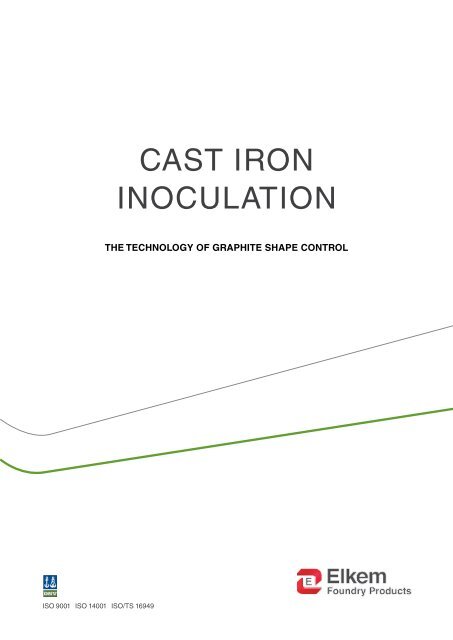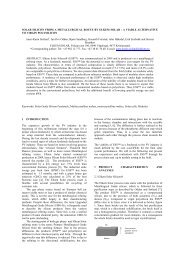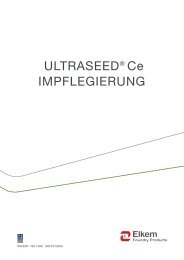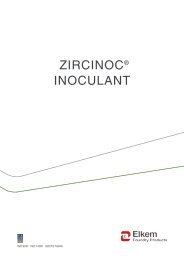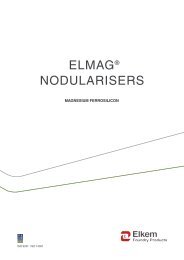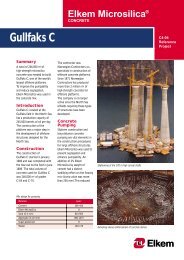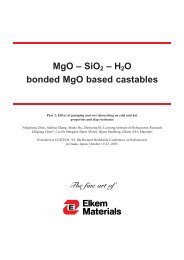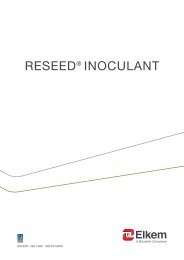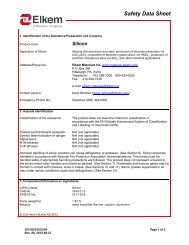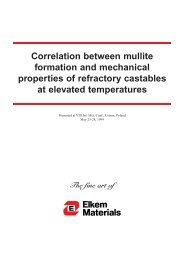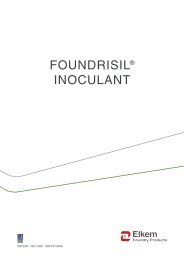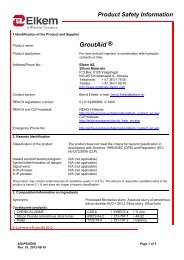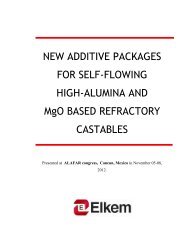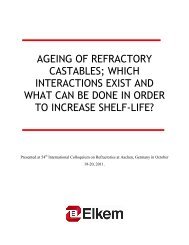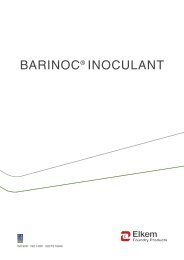CAST IRON INOCULATION - Elkem
CAST IRON INOCULATION - Elkem
CAST IRON INOCULATION - Elkem
You also want an ePaper? Increase the reach of your titles
YUMPU automatically turns print PDFs into web optimized ePapers that Google loves.
<strong>CAST</strong> <strong>IRON</strong><br />
INOCULAtion<br />
THE TECHNOLOGY OF GRAPHITE SHAPE CONTROL<br />
ISO 9001 ISO 14001 ISO/TS 16949
<strong>CAST</strong> <strong>IRON</strong> <strong>INOCULATION</strong><br />
THE TECHNOLOGY OF GRAPHITE SHAPE CONTROL<br />
<strong>Elkem</strong> manufactures and markets a<br />
series of high quality inoculants to treat<br />
cast iron and ensure the production of<br />
an ideal graphite shape, distribution<br />
and freedom from chill (cementite). All<br />
inoculants are available in sizes suitable<br />
for ladle or in-stream additions.<br />
This brochure describes some of the<br />
conditions in the production of cast iron<br />
that call for the addition of an inoculant<br />
to ensure the reliable production of a<br />
sound, strong, tough, machinable casting.<br />
The mechanism of inoculation and<br />
graphite nucleation in cast iron during<br />
solidification is also described.<br />
What is Inoculation of Cast Iron<br />
Inoculation is the means of controlling<br />
structures and properties of cast iron<br />
by minimizing undercooling and<br />
increasing the number of nucleation<br />
sites during solidification. An inoculant<br />
is a material added to the liquid iron<br />
just prior to casting that will provide<br />
suitable sites for nucleation of graphite<br />
during the subsequent cooling. Traditionally,<br />
inoculants have been based<br />
on graphite, ferrosilicon or calcium<br />
silicide. Almost exclusively, inoculants<br />
today are ferrosilicon based containing<br />
small quantities of active elements<br />
such as Al, Ba, Ca, Sr, Zr and RE (Rare<br />
Earth metals).<br />
The purpose of inoculation is to assist<br />
in providing sufficient nucleation sites<br />
for dissolved carbon to precipitate<br />
as graphite rather than iron carbide<br />
(cementite, Fe 3<br />
C). This is done by preventing<br />
undercooling below the metastable<br />
eutectic temperature where<br />
carbidic (white) structures are formed.<br />
The iron solidification mechanism is<br />
prone to form chilled iron structures<br />
when the inoculation is inadequate.<br />
There are several reasons why chilled<br />
structures are normally undesirable.<br />
They are hard and brittle and interfere<br />
with machining, necessitate additional<br />
heat treatment operations, resulting in<br />
nonconformance with specifications<br />
and, in general, increase the total cost<br />
of production.<br />
Inoculation changes the structure of<br />
cast iron by altering the solidification<br />
process. A look at the solidification<br />
process for hypoeutectic grey iron<br />
(iron with a carbon equivalent less<br />
than 4.3) helps in understanding the<br />
effect of inoculation.<br />
The first metal to solidify in hypoeutectic<br />
grey iron is primary austenite. As<br />
cooling continues, the remaining iron<br />
grows richer in dissolved carbon. Eventually,<br />
the liquid reaches the eutectic<br />
composition of 4.3% carbon equivalent,<br />
at which final or eutectic solidification<br />
would start under equilibrium conditions.<br />
However, equilibrium solidification does<br />
not occur under practical foundry conditions.<br />
Due to variations in chemistry,<br />
pouring temperature, solidification rate,<br />
section thickness and other conditions,<br />
the metal will cool below the eutectic<br />
temperature before the start of final<br />
solidification.<br />
If the undercooling is slight, random<br />
graphite flakes form uniformly in the<br />
iron matrix, see Figure 1. This is known<br />
as Type A graphite. As the undercooling<br />
increases, the graphite will branch,<br />
forming abnormal patterns. This is<br />
known as Types B, D and E graphite.<br />
A further increase in undercooling will<br />
suppress the formation of graphite<br />
and results in a hard white iron carbide<br />
structure.<br />
The role of the inoculant is to produce<br />
nuclei in the liquid iron melt which<br />
enhance the graphite nucleation with<br />
a low degree of undercooling. This will<br />
in turn, promote the formation of Type<br />
A graphite structures in grey iron,<br />
and a high number of small graphite<br />
nodules in ductile iron.<br />
Figure 1: Graphite type versus undercooling.<br />
1. Structure and Phases in Cast Iron<br />
The structure of cast iron has a<br />
domi nant influence on strength and<br />
machinability, and in order to obtain a<br />
machinable grey iron structure for thin<br />
sections, the addition of an inoculant<br />
to molten iron is widely practiced<br />
and often absolutely necessary. For<br />
convenience, potential difficulties with<br />
machinability can be determined by<br />
carrying out a hardness test (Brinell<br />
hardness) on iron castings and, in<br />
general, machinability improves with<br />
decreasing hardness. The cast iron<br />
structure can be influenced at two<br />
distinct stages in the production route:<br />
• during solidification<br />
• during heat treatment<br />
However, for economic reasons, the<br />
desired structure should be achieved<br />
during solidification without the necessity<br />
for heat treatment.
The microstructure of an iron casting<br />
consists of several phases, each having<br />
varying levels of carbon, iron and other<br />
elements present. Table 1 shows the<br />
analysis and specific densities of the<br />
solid and liquid phases which take<br />
part in the solidification process. When<br />
solidification is complete, the following<br />
combination of phases may be found:<br />
1) Austenite + Graphite<br />
= GREY structure<br />
2) Austenite + Graphite + Cementite<br />
= MOTTLED structure<br />
3) Austenite + Cementite<br />
= WHITE structure<br />
This review demonstrates that solidifica<br />
tion results in a minimum of two solid<br />
phases; and austenite is present in all<br />
the phase combinations. As the casting<br />
cools, the austenite subsequently transforms<br />
to pearlite and/or ferrite in solid<br />
state (eutectoid transformation).<br />
Of all the solid phases listed above,<br />
cementite has the highest hardness<br />
(~660 HB), whilst graphite is a relatively<br />
soft material of low density, which<br />
can act as a lubricant. Hardness and<br />
machinability of the as-cast structure<br />
are, therefore, influenced by the relative<br />
amounts of cementite and graphite, with<br />
austenite playing only a minor role.<br />
Table 1: Approximate analysis and<br />
specific densities of phases in the<br />
solidification range of cast iron with<br />
2.4% Si.<br />
2. Structure Stability<br />
A metastable white or mottled structure<br />
can be transformed into a stable grey<br />
structure by annealing, but the reverse<br />
transformation is not possible as the<br />
stable structure represents the lowest<br />
possible energy level (at a given<br />
temperature and composition). The<br />
graphite produced by annealing will<br />
have a different structure to that formed<br />
during solidification. Cementite,<br />
austenite and liquid iron have similar<br />
densities and all contain carbon in<br />
solution, see Table 1. No major redistribution<br />
of the atom species is required<br />
for a white structure to be produced<br />
during solidification. However, the<br />
formation of a stable grey structure<br />
containing graphite is quite different.<br />
Graphite precipitated from molten iron<br />
is virtually pure carbon, and since it<br />
has a lower specific density than the<br />
alternative phases; a major redistribution<br />
of atoms is required to develop<br />
a stable structure. A slow rate of solidification<br />
is therefore more likely to<br />
produce a grey iron structure.<br />
The precipitation of cementite, re quir ing<br />
less atom redistribution than graphite,<br />
will be more likely during rapid solidification.<br />
This can be demonstrated by<br />
examining a typical wedge test specimen.<br />
The narrow tip of the wedge solidifies<br />
at a faster rate than the thicker<br />
section at the base of the wedge, and<br />
will show a white structure whilst the<br />
area of slow cooling at the base will<br />
display a grey structure, see Figure 2.<br />
Consequently, a slow rate of solidification<br />
(slow cooling rate) and a small<br />
value of undercooling encourages the<br />
formation of a grey structure with good<br />
machinability and discourages a hard<br />
white structure.<br />
Figure 2: Chill Wedge with fast solidifying<br />
‘white’ tip and slowly cooled ‘grey’ base.<br />
3. Influence of Elements on As-Cast Structure<br />
Within the composition of cast iron,<br />
graphitizing elements will promote the<br />
carbon-carbon bond to produce graphite<br />
in the as-cast structure, whereas<br />
carbide stabilizing elements promote<br />
the carboniron bond and cementite will<br />
appear in the structure. Table 2 lists a<br />
number of such stabilizing elements.<br />
As an example, in malleable cast irons<br />
the need for the as-cast structure to<br />
solidify white determines that the silicon<br />
level is much lower than in grey irons.<br />
Also, since chromium is a carbide<br />
promoting element, it has to be kept at<br />
a low level to allow transformation to a<br />
graphitic structure during subsequent<br />
heat treatment. In normal furnace<br />
charge materials, steel and external<br />
cast iron scrap may be heterogeneous<br />
materials, especially on different deliveries,<br />
with contents of Cr, Cu, Sn, Sb, V,<br />
Mo, Ti, etc., depending on the original<br />
source and ultimately on the ability of<br />
the scrap dealer.<br />
Pig iron produced from steel scrap can<br />
also display a similar variable response<br />
to inoculation due to fluctuating trace<br />
element contents. A more consistent<br />
response to inoculation is attainable by<br />
adopting a charge containing a reasonable<br />
proportion of ore-based pig iron<br />
due to its low level of trace elements of<br />
the carbide stabilising type.<br />
Controlling the concentration of trace<br />
elements allows the foundryman a means<br />
of promoting grey as-cast structures<br />
and, also, helps in avoiding other undesirable<br />
effects of trace elements on<br />
microstructure and properties.<br />
Table 2: Graphitizing and carbide<br />
promoting elements.
4. Influence of Nuclei on Solidfication Structure<br />
When crystallisation of eutectic cast<br />
iron in chilled specimens is studied,<br />
a gradual advance of the solidification<br />
front is revealed. Transformation does not<br />
take place instantaneously or uniformly<br />
over a cross section. Initial solidification<br />
occurs at the surface from distinct<br />
crystallization centres and after some<br />
time a solid/liquid interface forms. Other<br />
isolated crystallisation centres are<br />
active in the remaining melt and initiate<br />
the formation of solid, see Figures 3<br />
and 4. These isolated areas are called<br />
eutectic cells.<br />
Eventually, cells grow at the expense<br />
of the liquid, and a solid cast structure<br />
develops. Each eutectic cell consists of<br />
graphite and austenite with graphite as<br />
the primary phase.<br />
Precipitation is initiated by randomly<br />
distributed crystallisation centres, called<br />
nuclei. These nuclei offer favourable sites<br />
for the deposition of carbon atoms and,<br />
subsequently, precipitation of graphite<br />
and austenite onto existing graphite<br />
continues. The morphology of these cells<br />
for grey iron shows a marked difference<br />
with that for nodular iron, as can be<br />
seen from Figure 3.<br />
• Grey iron: graphite lamellae start<br />
growing from a common centre and<br />
stays in contact with the melt as austenite<br />
fills the spaces between<br />
the lamellae.<br />
• Nodular iron: a graphite nodule forms<br />
first and is surrounded by austenite at<br />
a later stage.<br />
In eutectic nodular iron, the nodule<br />
number is virtually identical with the<br />
number of eutectic cells.<br />
The mechanism described is for eutectic<br />
solidification and is not influenced by<br />
the presence of kish (primary) graphite<br />
or austenite dendrites.<br />
Austenite<br />
Graphite<br />
Austenite<br />
Graphite<br />
Figure 3: Eutetic cells: lamellar (top),<br />
nodular (bottom) graphite .<br />
The nuclei substances can be more easily<br />
observed in nodular graphite iron than<br />
in grey iron, since it is easy to locate the<br />
centre of a graphite spheroid. Measurements<br />
have shown that the nuclei are<br />
between 0.5 to 2.0 microns in diameter,<br />
with a bulk chemical composition of<br />
magnesium sulphide and magnesium<br />
silicate. A similar investigation of nuclei<br />
composition for grey iron has shown that<br />
the nucleus has a core of a complex<br />
aluminium-X-oxide where X can be<br />
Ca, Ba, Sr, Ce, Zr surrounded by the<br />
manganese sulphide.<br />
Figure 4: Solidification of near eutetic<br />
iron 2 .<br />
5. Prerequisites for Successful Inoculation<br />
5.1 Number of Nuclei<br />
About 2.4wt% graphite and 97.6wt%<br />
austenite are formed during the crystallization<br />
of eutectic (nodular) cast iron,<br />
which corresponds to approximately<br />
8 vol% graphite and 92 vol% austenite.<br />
The mean diameter of graphite nodules<br />
is usually between 10 – 80 microns,<br />
although lower and higher values are<br />
possible. This leads to about 3000 to<br />
30,000 nodules per cubic millimetre<br />
depending on the section size (cooling<br />
rate) of the casting. The total number of<br />
possible nuclei for graphite (inclusions)<br />
will be at least one order of magnitude<br />
larger than this graphite nodule density.<br />
This means that the number of inclusions<br />
or possible nuclei for graphite is at least<br />
100,000 per cubic millimetre and that<br />
only a small fraction of these nuclei<br />
actually nucleates graphite during<br />
solidification 1 . Table 3 gives examples<br />
of number densities and mean particle<br />
sizes for nuclei and graphite nodules in<br />
ductile cast iron under various inoculation<br />
conditions. As can be seen from<br />
the table, the number and mean size of<br />
nuclei particles are unaffected by the<br />
inoculant addition, although the nodule<br />
characteristics obtained after solidification<br />
are strongly dependent on the<br />
type of inoculant used. These findings<br />
will be discussed below.<br />
The calculations used to generate these<br />
figures contain certain assumptions,<br />
but one can safely conclude that:<br />
• The number of nuclei per volume of<br />
melt is extremely high, and approximately<br />
one order of magnitude larger<br />
than the number of graphite nodules<br />
actually nucleated;<br />
• The ability of the particles to nucleate<br />
graphite is strongly affected by the<br />
inoculant addition.<br />
In order to obtain a nucleation event, a<br />
certain degree of undercooling during<br />
solidification is required. But since<br />
different nuclei phases initiate graphite<br />
nucleation at different undercooling<br />
levels, it is preferable to have a large<br />
number of nuclei particles which can<br />
initiate nucleation at very small undercooling.<br />
This is achieved by the addition<br />
of an inoculant to the melt just prior to<br />
casting.
5.2 Constituents of an inoculant<br />
Most of the inoculant material is socalled<br />
‘carrier’ material that is doped<br />
with a minor additive (“nucleant”),<br />
which produces nucleating particles<br />
in the iron melt. These particles will, in<br />
turn, initiate the crystallization of graphite.<br />
The carrier (e.g. silicon and iron<br />
combined as ferrosilicon) should have<br />
the following characteristics:<br />
• provide fast and homogeneous distri -<br />
bution of the nucleant in the melt<br />
• have a composition that is compat ible<br />
to the analysis of the melt<br />
• form an alloy between the nucleant<br />
and the carrier<br />
• be cost efficient<br />
Trials using very pure ferrosilicon as an<br />
inoculant have demonstrated that it<br />
does not have any nucleating effect for<br />
graphite 1,3,4 as shown in Table 3.<br />
The nucleant, e.g. Ca, Sr, Ba or Al only<br />
needs a limited presence and it is<br />
beneficial if the nucleant forms an alloy<br />
with the carrier. Also, the nucleant must<br />
have a limited solubility in cast iron,<br />
and form stable compounds with the<br />
other elements forming the nuclei particles<br />
(e.g. sulphur and oxygen). Good<br />
nucleation effect may be achieved if<br />
the ferrosilicon contains small but controlled<br />
amounts of calcium, strontium or<br />
barium in the range of 0.6 to 2.0%.<br />
Table 3: Example of nuclei and nodule<br />
number densities, average<br />
diameters and volume fractions 1 .<br />
5.3 Composition of the Nuclei<br />
in Ductile Iron<br />
Laboratory test results are used in this<br />
section to explain the role of calcium<br />
as an example of a trace element<br />
behaving as the nucleant in ferrosilicon.<br />
Calcium will occur in ferrosilicon as a<br />
silicide (CaSi 2<br />
). Calcium has virtually no<br />
solubility in iron, and reacts with components<br />
in the melt to form sulphides<br />
and oxides.<br />
In magnesium treated cast irons, the<br />
inclusions contain mainly magnesium,<br />
calcium, sulphur, silicon and oxygen.<br />
These are primary reaction products<br />
of the magnesium treatment. The<br />
inclusions are composed of a sulphide<br />
core and a faceted outer silicate shell.<br />
The sulphide core contains both MgS<br />
and CaS, while the outer shell consists<br />
of complex magnesium silicates<br />
(e.g. MgO•SiO 2<br />
, 2MgO•SiO 2<br />
). These<br />
phases will not act as potent nucleation<br />
sites for graphite during solidification<br />
because of a large nucleus/ graphite<br />
interfacial energy barrier. The interfacial<br />
energy barrier is the controlling factor in<br />
heterogeneous nucleation behaviour.<br />
Figure 5: Transmission electron<br />
micrograph of duplex sulphide/oxide<br />
inclusion in ductile iron (left).<br />
Schematic representation of an inclusion<br />
after inoculation by a calcium<br />
containing ferrosilicon. The surface<br />
layer of calcium silicate is the effective<br />
phase for graphite nucleation (right). 1
After inoculation with a Ca-containing<br />
ferrosilicon, hexagonal silicate phases of<br />
the CaO•SiO 2<br />
and the CaO•Al 2<br />
O 3<br />
• 2SiO 2<br />
type will form at the surface of the existing<br />
oxide inclusions produced during<br />
nodularisation. These silicates will act<br />
as very favourable nucleation sites for<br />
graphite during solidification, due to<br />
their hexagonal crystal structure, which<br />
matches the graphite crystal lattice<br />
very well (i.e. low energy interface).<br />
Figure 5 shows a typical inclusion in<br />
ductile cast iron which is formed after<br />
nodularisation (left), and a schematic<br />
representation of the inclusion composition<br />
after inoculation (right). The surface<br />
shell contains hexagonal calcium<br />
silicates formed during inoculant addition,<br />
while the bulk particle is a product<br />
of the nodularisation treatment. Hence,<br />
the inoculation does not increase the<br />
total number of nuclei particles in the<br />
melt, but rather modifies the surface of<br />
the already existing products from nodularisation.<br />
This explains why the number<br />
density of particles in uninoculated<br />
and inoculated ductile iron melts are<br />
the same (Table 3), while the resulting<br />
nodule numbers will differ greatly due<br />
to the inclusion surface modification.<br />
When inoculation is carried out with<br />
a strontium or barium containing ferrosilicon<br />
inoculating hexagonal silicates<br />
equivalent to the calcium silicates<br />
(CaO•SiO 2<br />
and CaO•Al 2<br />
O 3<br />
•2SiO 2<br />
) will<br />
be formed (i.e. SrO•SiO 2<br />
, SrO•Al 2<br />
O 3<br />
•2SiO, BaO•SiO 2<br />
and BaO•Al 2<br />
O 3<br />
•2SiO 2<br />
)<br />
5.4 Composition of nuclei in grey iron<br />
Recent research results have identified<br />
a three step nucleation process for<br />
generating graphite flakes in grey iron.<br />
By means of electron microscope investigations,<br />
it has been revealed that<br />
a nucleus for a graphite flake consists<br />
of a particle with a body of manganeseand<br />
calcium-sulphide surrounding a<br />
nucleus core of complex Al 2<br />
O 3<br />
–XO<br />
oxides, see Figure 6. The core oxide<br />
contains elements such as calcium,<br />
barium, strontium, zirconium, and rare<br />
earth elements. Towards the surface<br />
of the manganese/calcium-sulphide<br />
body, even more complex compounds<br />
have been observed on which the<br />
graphite has grown.<br />
The hypothesis is that the oxides form<br />
as stable elements in the iron melt first.<br />
Secondly, manganese and calcium<br />
sulphides grow on these oxides until<br />
a desired size and a more complex<br />
faceted compound appears on the surface.<br />
The third step is that the graphite<br />
starts to grow on this faceted surface<br />
and grows along its base planes of<br />
hexagonal structure.<br />
One interesting observation was that<br />
aluminium seems to play a key role in<br />
the nucleation process in conjunction<br />
with other elements. Testing of iron with<br />
very low levels of aluminium showed<br />
poorer performance than iron with a<br />
certain level of aluminium. It can be<br />
concluded that final content of aluminium<br />
in grey iron should be between<br />
0.005 and 0.010% in order to maximise<br />
eutectic cell count in grey iron. This<br />
aluminium content range is and has to<br />
be less than the 0.015 – 0.25% Al, as<br />
this range for pin-hole susceptibility<br />
influenced by aluminium.<br />
As a result of these observations, <strong>Elkem</strong><br />
has invented the Preseed preconditioner<br />
that contains zirconium and<br />
aluminium, to be added to the iron melt<br />
in the furnace or well ahead of inoculation,<br />
in order to increase the potency<br />
of the melt for inoculation<br />
Figure 6: Transmission electron micrographs of complex sulphide/oxide inclusion in grey iron and profile of chemical<br />
composition through the nucleus.
5.5 Specification of Inoculants<br />
The chemical composition and reliability<br />
of the analysis from lot to lot is important<br />
if a ferroalloy is to be considered as a<br />
good and consistent inoculant. Many<br />
foundrymen insist on silicon and phosphorus<br />
analyses in pig iron, but pay little<br />
attention to the analysis of the inoculant,<br />
or vice versa. The preceding paragraphs<br />
indicate quite clearly that the minor<br />
constituents in ferroalloys, not the major<br />
constituents (usually sili con), are critical<br />
for the performance as inoculants. All the<br />
<strong>Elkem</strong> inoculants are alloys that have<br />
been smelted and alloyed to the quoted<br />
specifications, and with the exception<br />
of Ultraseed ® inoculant, no further additions<br />
have to be mechanically blended<br />
with the alloy. The analysis guaranteed<br />
by the specification ensures consistent<br />
inoculant properties from lot to lot. The<br />
inoculants listed in Table 4 differ by<br />
analysis, price and application. The<br />
foundry experts of <strong>Elkem</strong> can give<br />
detailed information on each inoculant<br />
and its individual features, and also<br />
suggestions as to the most suitable alloy<br />
for a specific foundry condition.<br />
5.6 Addition Technique<br />
Chemical considerations alone will not<br />
ensure satisfactory results since equal<br />
attention must be paid to addition technique.<br />
For ladle inoculation this means<br />
a continuous addition of inoculant to the<br />
stream of iron (normally added between<br />
one third and two thirds of ladle filling)<br />
so that the high turbulence encourages<br />
fast and homogeneous distribution of<br />
the alloy. Stream inoculation may be<br />
practised, in conjunction with automatic<br />
pouring furnaces, using finer sized<br />
grades of the above inoculants at lower<br />
addition rates. Similarly, inoculant fade<br />
can be overcome by reducing the time<br />
interval between the inoculant addition<br />
and solidification by placing the inoculant<br />
piece, or insert, into the gating<br />
system. The reaction with liquid iron<br />
occurs within the mould and this is<br />
known as in-mould inoculation.<br />
Fading is the reduction in inoculation<br />
effect with increasing time taken to pour<br />
inoculated iron. <strong>Elkem</strong> inoculants have<br />
been assessed against untreated reference<br />
melts and even after 10 minutes<br />
the inoculation effect of the treated melt<br />
proved to be good. Provided ladle inoculation<br />
has been carried out in a satisfactory<br />
way and the ladle is not delayed<br />
for an excessive period before pouring,<br />
the need for mould inoculation can be<br />
avoided in most cases.<br />
Table 4: <strong>Elkem</strong> preconditioner, inoculants and inserts for grey and ductile irons.<br />
Alinoc ® , Barinoc ® , Elcast ® , Foundrisil ® ,Reseed ® , SMZ ® , Superseed ® , Ultraseed ® , Vaxon ® and Zircinoc ®<br />
are registered trademarks owned by <strong>Elkem</strong> AS. Preseed is a trademark of <strong>Elkem</strong> AS.
6. Control of Inoculation<br />
Although nuclei cannot be observed<br />
directly at solidification temperatures,<br />
they have an effect on some properties<br />
which can be measured by:<br />
• recording cooling curves<br />
• measuring depth of chill in chill<br />
wedges<br />
• counting the number of eutectic cells<br />
• counting the number of graphite<br />
nodules<br />
6.1 Cooling Curves<br />
Cooling curves record the changes<br />
in temperature with time as a consequence<br />
of a change of energy within<br />
the system. A deviation from normal<br />
cooling indicates the occurrence of a<br />
source of heat such as the heat of<br />
crystallization released by a precipitating<br />
phase. The location of the inversion<br />
points on the generally S-shaped<br />
cooling curve in the region of eutectic<br />
crystallization indicates the tendency<br />
of the melt to solidify “grey” or “white”.<br />
A high level of nucleation promotes a<br />
higher arrest temperature which, by<br />
avoiding the white eutectic, will result<br />
in less risk of carbide formation.<br />
Conversely, when the inversion point is<br />
at a low level on the cooling curve, there<br />
will be a tendency for cementite to<br />
precipitate instead of graphite giving a<br />
“white” structure. An increased cooling<br />
rate, as found in thin sections, will increase<br />
the degree of undercooling that<br />
must be balanced by an increased<br />
number of active nuclei to avoid the<br />
formation of white iron. In the iron-carbon<br />
system there is only a 7 ºC interval<br />
between “grey” solidification and sufficient<br />
undercooling to cause “white”<br />
solidification. In Figure 7 the cooling<br />
curve for an uni noculated reference<br />
melt is compared with a curve from a<br />
melt inoculated with 0.25% inoculant<br />
addition.<br />
The uninoculated melt shows inversion<br />
at 1145 ºC whereas inversion occurs<br />
at 1162 ºC for the inoculated melt. This<br />
means that the uninoculated melt is<br />
undercooled by 20 ºC and the inoculated<br />
melt by 3 ºC, which gives “white” and<br />
“grey” solidification, respectively.<br />
Figure 7: Solidfication curves for<br />
uninoculated ductile iron (a), and<br />
inoculated ductile cast iron (b)<br />
(30 mm section size).<br />
6.2 Chill Testing<br />
The traditional method to determine the<br />
tendency of a melt to solidify “grey” or<br />
“white” is by examining chill wedges.<br />
The larger the zone of white iron, the<br />
fewer the number of nuclei that were<br />
active in initiating a “grey” solidification.<br />
Figure 8 shows chill wedges from a<br />
foundry which had an average 11.2 mm<br />
of chill for a period of two week on uninoculated<br />
cupola iron. By adding 0.2%<br />
FeSi (85% Si), the average chill depth<br />
was reduced and with 0.125% Superseed<br />
® inoculant addition, the chill depth<br />
was reduced even further.<br />
6.3 Eutectic Cell Count<br />
The number of eutectic cells in grey iron<br />
can be determined on etched microspecimens.<br />
If an effective inoculant has<br />
been added to the melt, there will be a<br />
large number of active nuclei to promote<br />
graphite precipitation at low undercooling<br />
during solidification. This will<br />
be represented on the micro-specimen<br />
by a high cell count for grey iron and<br />
a high nodule count for ductile iron.<br />
Table 5 shows the result of cell counts<br />
after inoculation. The eutectic cell<br />
number increases as the inoculant<br />
addition to the base melt is increased.<br />
Other factors, such as over-inoculation<br />
leading to shrinkage proprensity, will influence<br />
the optimum inoculant addition.
Table 5: Eutectic cell count (30 mm round bars).<br />
Figure 8: Cupola melted grey iron; no<br />
inoculation (left), inoculated with 0.2%<br />
FeSi85% (centre), and inoculated with<br />
0.125% Superseed ® inoculant (right).<br />
7. Fading of Inoculation<br />
7.1 Principle Effects<br />
The effects of inoculation are at a maximum<br />
immediately after the addition of the<br />
inoculant. The rate of inoculant fading,<br />
which depends upon the composition<br />
of the inoculant and the condition of the<br />
iron to which it is added, may be very<br />
rapid and much of the inoculating effect<br />
may be lost in the first few minutes after<br />
the addition. The principal effects of<br />
fading are:<br />
• to cause greater undercooling to take<br />
place during eutectic solidification<br />
and to lead to a greater tendency to<br />
chilling in grey and ductile cast irons,<br />
particularly in thin sections;<br />
• to reduce the number of nodules<br />
formed in ductile iron and to cause a<br />
deterioration in their shape. If suffic ient<br />
ly severe, the deterioration in shape<br />
may affect the mechanical properties<br />
of the casting;<br />
• to reduce the number of eutectic cells<br />
growing in flake graphite irons result<br />
ing in a less uniform size distribution<br />
of graphite in the casting and a<br />
reduction in mechanical properties.<br />
There are some well established facts<br />
concerning fading which are of practical<br />
significance:<br />
• all inoculants fade;<br />
• there is no period after inoculation<br />
during which fading does not occur.<br />
To obtain the maximum effect, metal<br />
should be cast as soon as possible<br />
after the addition of inoculant;<br />
• some inoculants fade more slowly<br />
than others;<br />
• inoculating effects vary according to<br />
inoculant composition. It is desirable<br />
that foundries should carry out tests<br />
to determine which is the most suit<br />
able inoculant for their purpose.
7.2 Coarsening of Inclusions<br />
It has previously been discussed that<br />
graphite nucleation occurs from nonmetallic<br />
inclusions in the melt. A significant<br />
coarsening of these inclusions<br />
occurs within the time interval between<br />
inoculation and solidification of the cast<br />
iron. This coarsening of inclusions will<br />
result in a reduction in the inclusion<br />
number density, consequently reducing<br />
the graphite nucleation frequency.<br />
Hence, the fading of inoculation can<br />
be explained by this coarsening of the<br />
inclusion population with time. Due to<br />
the coarsening, the total number of<br />
possible nucleation sites for graphite<br />
during solidification is reduced.<br />
Figure 9 shows a plot of the number<br />
density of inclusions in cast iron as a<br />
function of holding time after inocu lation.<br />
7.3 Effects of Various Inclusions<br />
Inoculants lose their ability to reduce<br />
chill and nucleate graphite if the metal<br />
is held for extended periods before<br />
casting. However, inoculants have<br />
different fading characteristics. The<br />
barium-based Barinoc ® inoculant<br />
produces a high initial number of<br />
nucleation sites throughout the holding<br />
period, thus making it an excellent<br />
inoculant for ladle treatments.<br />
Foundrisil ® inoculant is an effective<br />
chill reducer for both low and high<br />
sulphur grey iron as well as ductile<br />
iron. Another effective inoculant that<br />
maintains the inoculation effect is the<br />
strontium-containing Superseed ®<br />
inoculant. Figure 10 shows the fading<br />
characteristics of some inoculants in<br />
cast iron.<br />
Figure 9: Coarsening behaviour of<br />
inclusions in liquid cast iron during<br />
holding.<br />
Figure 10: Fading characteristics for<br />
various inoculants in cast iron.<br />
8. Inoculation and Cast Iron Properties<br />
8.1 Inoculation and Strength<br />
Inoculation increases the number of<br />
eutectic cells (or nodules) which leads<br />
to a finer structure of the iron, and in<br />
particular, this will cause an increase in<br />
tensile strength in hypoeutectic irons.<br />
Figure 11 shows the increase in tensile<br />
strength by adding an inoculant.<br />
8.2 Inoculation and Machinability<br />
Inoculation increases the number of<br />
potent nuclei that will promote graphite<br />
nucleation at low undercooling. Improved<br />
machinability is achieved by<br />
inoculation suppressing the formation<br />
of hard un-machinable white iron<br />
structures. Inoculation also reduces<br />
section sensitivity. While uninoculated<br />
irons will show a wide variation in<br />
hardness, inoculated grey or nodular<br />
cast irons will show more consistent<br />
hardness values over a wide range of<br />
sections, Figure 12.<br />
Figure 12: The wall thickness sensitivity<br />
of (Brinell) hardness can be<br />
reduced by an inoculant (partly calculated<br />
from Rockwell -B* and -C**).<br />
Figure 11: Increasing inoculant<br />
additions improve tensile strength.<br />
The final analyses of these trial melts<br />
are identical after inoculation.
9. Inoculation and Shrinkage<br />
The solidification of grey iron is characterized<br />
by the formation of a skin type<br />
array of eutectic cells at the mould/metal<br />
interface, followed by the development<br />
of eutectic cells ahead of the advancing<br />
solidification front. Newly formed graphite<br />
compensates partly or fully for the liquid<br />
iron contraction, provided it precipitates<br />
within a relatively rigid “skin”, which is<br />
charac teristic of uninoculated grey iron.<br />
How ever, if the mode of solidification is<br />
changed, the good shrinkage characteristics<br />
can be jeopardized, especially if<br />
a rigid skin cannot be developed at the<br />
mould/metal interface leaving the mould<br />
directly exposed to ferrostatic pressure.<br />
Eventually, the mould may yield under the<br />
ferrostatic pressure from the remaining<br />
liquid, and the increased volume of the<br />
mould cavity becomes too high for compensation<br />
by graphite precipitation at the<br />
end of solidification. Some shrinkage may<br />
occur as a result of excessive dilation of<br />
the mould although mould geometry<br />
will have an influence.<br />
Unfortunately, inoculation changes the<br />
mode of solidification in such a way that<br />
the rigidity of the “skin” is decreased.<br />
Inoculant additions should not become<br />
excessive to avoid shrinkage and yet the<br />
addition should be adequate to ensure<br />
“grey” solidification. Test specimens,<br />
Figure 13, show that for an equivalent<br />
chill depth, the eutectic cell count will be<br />
lower when using Superseed ® inoculant<br />
in place of foundry grade ferrosilicon.<br />
The lower cell count reduces the ferrostatic<br />
pressure on the mould and improves<br />
the tendency to avoid shrinkage<br />
defects.<br />
Since the eutectic cell count for nodular<br />
cast iron is much higher than for grey iron,<br />
one would expect a greater shrinkage<br />
tendency, and it is interesting to see<br />
that the solidification pattern is in fact<br />
similar to over-inoculated grey iron.<br />
Ultraseed ® inoculant has proven highly<br />
successful in providing fresh nucleation<br />
sites to ductile irons of long holding time<br />
where the base iron or magnesium<br />
treated iron have been held for prolonged<br />
times before addition of the<br />
post inoculant. Such long hold times<br />
are well known to reduce the overall<br />
capabilities of the iron prior to inoculation<br />
resulting in so-called “dead” iron.<br />
Ultraseed ® inoculant will thus reinstall<br />
good nucleation effectiveness from<br />
reactions with its sulphur and oxygen<br />
content forming new nucleation sites.<br />
Due to the powerful effects of Ultraseed ®<br />
inoculant on raising nodule count and<br />
improving chill protection, it has been<br />
found that the tendency to shrinkage<br />
formation is also reduced with this inoculant.<br />
Especially, the type of shrinkage<br />
that often occurs as small porosities in<br />
hot-spot sections of the complex castings;<br />
appear to be effec tively reduced<br />
or even eliminated by Ultraseed ® inoculant.<br />
Figure 14 shows an example of<br />
microshrinkage porosity that has been<br />
minimized by the use of Ultraseed ®<br />
inoculant.<br />
Figure 13: Comparison of the eutectic<br />
cell count in 5 mm sections at about<br />
equal chill depth (from BCIRA).<br />
Figure 14: Example of micro-shrinkage prorosity in ductile iron part that has been<br />
minimized by Ultraseed ® inoculant (left), compared to manganese-zirconium<br />
containing inoculant (right).
10. Product Development<br />
Based on a comprehensive under standing<br />
of the mechanisms of ino culation<br />
described in this brochure, <strong>Elkem</strong> has,<br />
over the years, evaluated many alternative<br />
alloy analyses to develop the current<br />
range of inoculants which includes the<br />
well established Superseed ® ,Ultraseed ® ,<br />
Reseed ® and Alinoc ® inoculants.<br />
Development of new improved alloys<br />
goes on continuously.<br />
Recently, Preseed preconditioner<br />
has been added to the portfolio as a<br />
novel preconditioner to enhance inoculation<br />
effect.<br />
For further information on <strong>Elkem</strong>’s<br />
extensive range of inoculants, please<br />
contact your local representative. The<br />
success of <strong>Elkem</strong> products worldwide<br />
justifies their elaborate development<br />
and provides a sound base for the<br />
foundryman to select the appropriate<br />
inoculant for his foundry’s particular<br />
requirements.<br />
References:<br />
1) Skaland, T.: Ph.D Thesis, The Norwegian Inst. of Tech., 1992<br />
2) Engler, S.: Giesserei, techn.-wiss.Beih., 17(1965), p 169/202<br />
3) Moore, A.: Brit.Foundrym. 68 (1974) March, p59/69 Patterson, V.H; Foundry 100 (1972) June, p 68/71<br />
4) Riposan et al: Investigation of the Effect of Residual Aluminium on Solidification Characteristics of Un-inoculated Ca/Sr-Inoculated Gray Irons. AFS 2004<br />
<strong>Elkem</strong> AS<br />
Foundry Products<br />
Hoffsveien 65B<br />
P.O. Box 5211<br />
Majorstuen<br />
N-0303, Oslo, Norway<br />
Telephone : +47 22 45 01 00<br />
Telefax : +47 22 45 01 52<br />
www.foundry.elkem.com<br />
Revised April 2012 © Copyright <strong>Elkem</strong> AS


